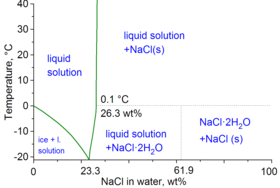Hydrohalite
Hydrohalite is a mineral that occurs in saturated halite brines at cold temperatures (below 0.1 °C). It was first described in 1847 in Dürrnberg, Austria. It exists in cold weather.

| Hydrohalite | |
|---|---|
| General | |
| Category | Halide mineral |
| Formula (repeating unit) | NaCl·2H2O |
| Strunz classification | 3.BA.05 |
| Crystal system | Monoclinic |
| Crystal class | Prismatic (2/m) (same H-M symbol) |
| Space group | P21/c |
| Identification | |
| Colour | Colourless or white |
| Diaphaneity | Transparent |
Hydrohalite has a high nucleation energy, and solutions will normally need to be supercooled for crystals to form. The cryohydric point is at −21.2 °C (−6.2 °F). Above this temperature liquid water saturated with salt can exist in equilibrium with hydrohalite. Hydrohalite has a strong positive temperature coefficient of solubility, unlike halite.[1] Hydrohalite decomposes at 0.1°C, giving a salty brine and solid halite. Under pressure, hydrohalite is stable between 7,900 and 11,600 atmospheres pressure. The decomposition point increases at the rate of 0.007°K per atmosphere. (for 1–1000 atmospheres).[1] The maximum decomposition temperature is at 25.8°C under 9400 atmospheres. Above this pressure the decomposition point goes down.[1]
Ceres
Hydrohalite was discovered on Ceres by Dawn,[2] suggesting an early ocean, possibly surviving as a relict ocean.
References
- Braitsch, O. (1971). "The Stability Conditions of Salt Minerals". Salt Deposits Their Origin and Composition. Springer. pp. 42–44. doi:10.1007/978-3-642-65083-3_2.
- De Sanctis, M.C., Ammannito, E., Raponi, A. et al. Fresh emplacement of hydrated sodium chloride on Ceres from ascending salty fluids. Nat Astron 4, 786–793 (2020). https://doi.org/10.1038/s41550-020-1138-8